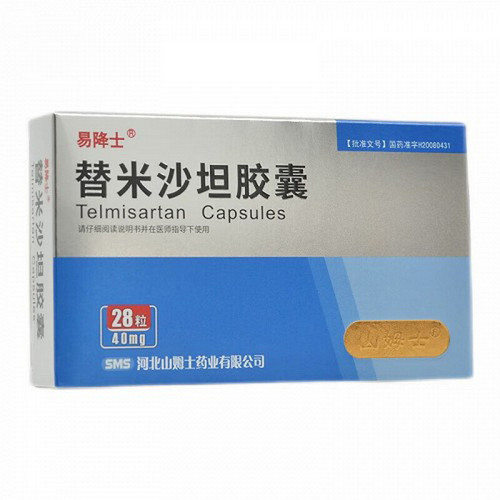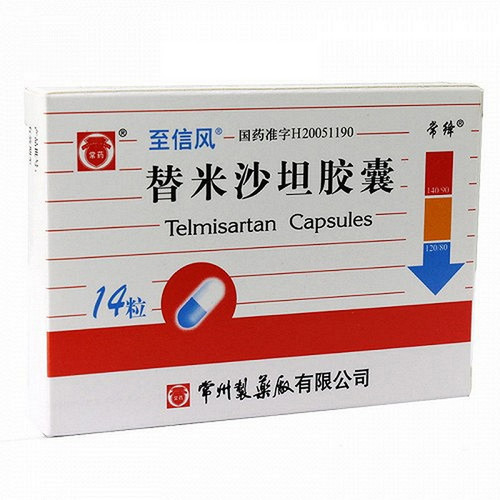Product Overview
[Drug Name]
Generic Name: Telmisartan Capsules
Trade Name: Shangerning
English Name: Telmisartan Capsules
Chinese Pinyin: Telmisartan Capsules
[Ingredients]
4'-[(2-n-propyl-4-methyl-6-(1-methylbenzimidazol-2-yl)-benzimidazol-1-yl)methyl]diphenyl-2-carboxylic acid = Telmisartan
[Properties]
This product is a capsule containing white or off-white granules.
[Indications]
For the treatment of essential hypertension.
[Dosage and Administration]
1. Adults: Dosage should be individualized. The usual initial dose is one 40 mg capsule once daily. Within the 20-80 mg dose range, the antihypertensive effect of telmisartan is dose-dependent. If optimal blood pressure is not achieved after treatment, the dose may be increased, up to a maximum of 80 mg (two capsules) once daily. This product can be used in combination with thiazide diuretics, such as hydrochlorothiazide, which have a synergistic antihypertensive effect. Because telmisartan does not reach its maximum effect until four to eight weeks after the start of treatment, this should be considered when increasing the dose.
2. Patients with renal impairment, especially those with mild or moderate renal insufficiency, do not require dose adjustment. Telmisartan cannot be eliminated by hemodialysis.
3. Patients with mild or moderate hepatic insufficiency, do not exceed 40 mg per day.
4. Elderly: No dose adjustment is required.
5. Children: Safety and efficacy data for this product have not been established in children and adolescents under 18 years of age.
[Adverse Reactions]
In placebo-controlled trials, the overall incidence of adverse events was similar for telmisartan (41.4%) and placebo (43.9%). The incidence of adverse events was not dose-related or related to patient gender, age, or race. The following adverse reactions were reported in a cumulative total of 5,788 hypertensive patients treated with telmisartan in clinical trials. Adverse reactions are categorized by frequency as follows: very common (>1/10); common (>1/100, <1/10); uncommon (>1/1000, <1/100); rare (>1/10,000, <1/1000); and very rare (<1/10,000). Common systemic reactions include back pain (e.g., sciatica), chest pain, flu-like symptoms, and infectious symptoms (e.g., urinary tract infections including cystitis); uncommon (>1/10,000, <1/1000); and very rare (<1/10,000). Common systemic reactions include back pain (e.g., sciatica), chest pain, flu-like symptoms, and infectious symptoms (e.g., urinary tract infections including cystitis); uncommon (>1/10,000, <1/1000); and visual disturbances and hyperhidrosis. Common central and peripheral nervous system reactions include dizziness. Common gastrointestinal reactions include abdominal pain, diarrhea, dyspepsia, and gastrointestinal disturbances; uncommon (>1/10,000, <1/1000); and dry mouth and flatulence. Common musculoskeletal reactions include arthralgia, leg cramps or pain, and myalgia; uncommon (>1/10,000, <1/1000); and tenosynovitis-like symptoms. Rare psychiatric effects: Anxiety. Common respiratory effects: Upper respiratory tract infections including pharyngitis and rhinitis. Common skin and adnexa effects: Skin abnormalities such as eczema. Additionally, since the marketing of telmisartan, isolated case reports have included erythema, pruritus, syncope, insomnia, depression, stomach discomfort, vomiting, hypotension, bradycardia, tachycardia, dyspnea, eosinophilia, thrombocytopenia, asthenia, and decreased work efficiency. Similar to other angiotensin II antagonists, rare cases have reported angioedema, urticaria, and other related adverse reactions. Laboratory findings: Compared to placebo, decreased hemoglobin or increased uric acid were occasionally observed in the telmisartan treatment group. Elevations in blood creatinine or liver enzymes were similar or lower with telmisartan and placebo.
[Contraindications]
1. Hypersensitivity to the active ingredient or any of the excipients of this product. 2. Pregnant women in their second or third trimesters or breastfeeding women. 3. Patients with biliary obstructive disease. 4. Patients with severe hepatic insufficiency. 5. Patients with severe renal impairment (creatinine clearance 30 ml/min).
[Precautions]
1. Hepatic Impairment: This product should not be used in patients with cholestasis, biliary obstructive disease, or severe hepatic dysfunction. Telmisartan is largely excreted via bile, and clearance of this product may be reduced in these patients. This product should be used with caution in patients with mild to moderate hepatic impairment. 2. Renovascular Hypertension: In patients with bilateral renal artery stenosis or unilateral renal artery stenosis of a functioning kidney, the risk of severe hypotension and renal impairment may be increased with the use of medications that affect the renin-angiotensin-aldosterone system. 3. Renal Impairment and Renal Transplant Patients: This product should not be used in patients with severe renal impairment (creatinine clearance 30 ml/min, see Contraindications). For patients with renal impairment, serum potassium and creatinine levels should be monitored regularly during use of this product. No data are available regarding the use of this product in patients shortly after a recent renal transplant. 4. Patients with Hypovolemia: In patients with hypovolemia or low blood sodium levels due to strong diuretic therapy, salt restriction, nausea, or vomiting, administration of this drug, especially after the first dose, may cause symptomatic hypotension. Therefore, serum sodium and blood volume levels should be corrected before using this drug. 5. Other Conditions Related to Stimulation of the Renin-Angiotensin-Aldosterone System: In patients whose vascular tone and renal function are primarily dependent on the activity of the renin-angiotensin-aldosterone system (such as those with severe congestive heart failure or underlying renal disease including renal artery stenosis), the use of drugs that affect this system may cause acute hypotension, hyperazotemia, oliguria, or rarely, acute renal failure. 6. Primary Aldosteronism: Antihypertensive drugs that inhibit the renin-angiotensin-aldosterone system are generally ineffective in patients with primary aldosteronism, so this drug is not recommended for use in these patients. 7. Aortic or mitral stenosis, and obstructive hypertrophic cardiomyopathy: As with other vasodilators, this drug should be used with caution in patients with aortic or mitral stenosis or obstructive hypertrophic cardiomyopathy. 8. Electrolyte Imbalance: Hyperkalemia may be caused by the use of drugs that affect the renin-angiotensin-aldosterone system, especially in patients with renal impairment and/or heart failure, and diabetes. For patients at risk, serum potassium levels should be closely monitored while taking this drug. Based on experience with other drugs that affect the renin-angiotensin system, the concomitant use of this drug with potassium-sparing diuretics, potassium supplements, potassium-containing salt substitutes, or other drugs that increase serum potassium levels (such as heparin) can increase serum potassium levels. Therefore, caution should be exercised when using this drug with these agents (see Drug Interactions). 9. Other: Similar to angiotensin-converting enzyme inhibitors, the antihypertensive effect of this drug and other angiotensin receptor antagonists is lower in blacks than in other ethnic groups. This may be related to the higher prevalence of low renal cord function in hypertensive individuals in blacks. As with other antihypertensive drugs, excessive blood pressure reduction can cause myocardial infarction or stroke in patients with ischemic heart disease or ischemic cardiovascular disease. 10. Effects on Driving and Operating Machinery: The effects of this drug on driving and operating machinery have not been studied. However, caution is advised when driving or operating machinery, as antihypertensive treatment can sometimes cause dizziness and drowsiness.
[Special Population Use]
Precautions for Children:
Safety and efficacy data for this drug have not been established in children and adolescents under 18 years of age.
Precautions for Pregnancy and Lactation:
1. Use During Pregnancy: Insufficient data exist to indicate whether this drug can be used in pregnant women. Animal studies have not demonstrated teratogenicity, but have demonstrated embryotoxicity. Therefore, as a precaution, telmisartan should not be used in the first two months of pregnancy. Appropriate alternative therapy should be sought before planning pregnancy. During the second and third trimesters of pregnancy (during the second and third trimesters), drugs that directly act on the renin-angiotensin system can cause fetal harm or even death. Therefore, telmisartan is contraindicated. Once pregnancy is confirmed, this drug should be discontinued as soon as possible. 2. Use During Breastfeeding: Because it is unknown whether this product is excreted in breast milk, this product is contraindicated during breastfeeding.
Precautions for Elderly Patients:
No dosage adjustment is required for this product.
[Drug Interactions]
1. Lithium: Concomitant use of lithium with angiotensin-converting enzyme inhibitors can cause reversible increases in blood lithium levels and toxic reactions. There have also been isolated cases of this condition caused by the concomitant use of lithium with angiotensin II receptor antagonists. Therefore, caution should be exercised when lithium is used concomitantly with this product. If concomitant use is necessary, blood lithium levels should be monitored during coadministration. 2. Some medications can affect blood potassium levels or cause hyperkalemia (such as ACE inhibitors, potassium-sparing diuretics, potassium supplements, potassium-containing salt substitutes, cyclosporine A, or other medications such as heparin sodium). If this product is used concomitantly with these medications, monitoring of blood potassium levels is recommended. Based on experience with other medications that affect the renin-angiotensin system, concomitant use of this product with these medications may result in increases in blood potassium levels (see Precautions). 3. Pharmacokinetic studies have investigated the interaction of this drug with digoxin, warfarin, hydrochlorothiazide, glyburide, ibuprofen, paracetamol, and amlodipine. This drug may increase the mean trough plasma concentration of digoxin by 20% (in some cases by 39%), so clinical monitoring of digoxin plasma concentrations is necessary. 4. This drug may enhance the antihypertensive effect of other antihypertensive drugs. Other clinically significant interactions have not been confirmed. 5. Based on their pharmacological properties, the following drugs may enhance the antihypertensive effect of antihypertensive drugs, including telmisartan: baclofen and amifostine. Additionally, alcohol, barbiturates, sedatives, hypnotics, or antidepressants may potentiate the orthostatic hypotensive effect. 6. When coadministered with telmisartan, the Cmax of the simvastatin metabolite (simvastatin acid) is slightly increased (1.34-fold) and its elimination is accelerated.
[Pharmacological Actions]
Telmisartan is an orally active, specific angiotensin II receptor (AT1) antagonist. It binds with high affinity to the AT1 subtype of the angiotensin II receptor (the known site of angiotensin II action). This binding is long-lasting, but without any partial agonist effects. The potential for receptor overstimulation due to increased angiotensin II levels caused by telmisartan is unknown. Telmisartan may decrease blood aldosterone levels. Telmisartan does not inhibit plasma renin or block ion channels. Angiotensin-converting enzyme (ACE) (kinase II) can also degrade bradykinin. Since telmisartan does not inhibit ACE, adverse effects due to enhanced bradykinin action are not expected. Telmisartan has no affinity for other receptors (including AT2 and other less characterized AT receptors whose functions are still unclear). Toxicology Studies: Doses used in preclinical safety studies, comparable to clinical therapeutic doses, caused decreases in erythrocyte indices (erythrocytes, hemoglobin, and hematocrit), altered renal hemodynamics (increased blood urea nitrogen and creatinine), and elevated serum potassium in normotensive animals. Renal tubular dilation and atrophy were observed in dogs. Gastrointestinal mucosal damage (erosion, ulceration, or inflammation) was also observed in rats and dogs. These adverse pharmacological reactions, known from preclinical studies to be common to both angiotensin-converting enzyme inhibitors and angiotensin II antagonists, can be prevented with oral salt supplementation.
Storage: Store at room temperature in a dry place.
Strength: 40 mg
Packaging: 40 mg x 48 s/box
Expiration Date: 24 months
Approval Number: National Medicine Standard H20041644
Manufacturer: Shandong Yijian Pharmaceutical Co., Ltd.







